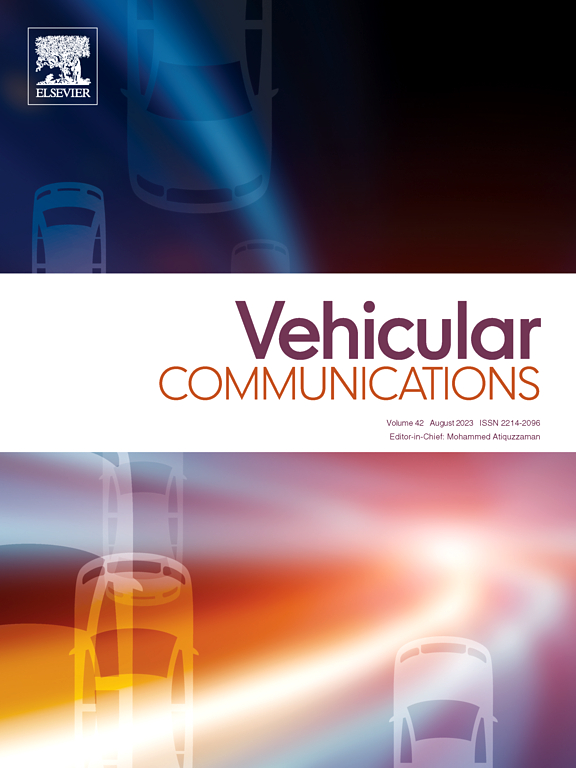PPORM: A PPO-assisted packet reordering mechanism of heterogeneous VANETs for enhancing goodput and stability in fog computing
IF 6.5
2区 计算机科学
Q1 TELECOMMUNICATIONS
引用次数: 0
Abstract
Integrated Vehicular Networks (VANETs) constructed through the collaboration of various heterogeneous networks, such as 4G, 5G, satellite networks, and Unmanned Aerial Vehicle (UAV) networks, provide an effective solution to the resource constraints between vehicles and edge fog computing nodes. Reordering Buffer (RB) is crucial in concurrent data transmission between vehicles and edge fog computing nodes via heterogeneous VANETs. RB is in charge of storing out-of-order packets, waiting for packets with smaller sequence numbers, and delivering in-order packets to upper-layer applications. However, current packet reordering mechanisms are challenging in providing stable and high goodput due to the inappropriate timeout timers and uneven delivery rules. In this paper, we propose a PPO-assisted packet reordering mechanism (PPORM) to achieve optimal control of packet delivery. We first transform the goodput maximization problem into the optimal timeout threshold of RB and the optimal delivery moment of each packet. Secondly, we introduce a Proximal Policy Optimization-assisted Timeout Threshold Updating (TTU) algorithm to dynamically adjust the threshold in response to real-time changes in network conditions. Further, we present a Multifactor Smooth Delivery (MSD) algorithm to regulate the optimal queuing delay for each packet and enhance the stability of the real-time throughput as much as possible. Experimental results show that PPORM improves goodput by and improves stability by compared with other baseline algorithms.
PPORM:一种ppo辅助的异构vanet包重排序机制,用于提高雾计算的稳定性和有效性
通过4G、5G、卫星网络、无人机(UAV)网络等多种异构网络协同构建的综合车辆网络(vanet),有效解决了车辆与边缘雾计算节点之间的资源约束问题。在车辆与边缘雾计算节点之间通过异构vanet进行数据同步传输时,重排序缓冲区(Reordering Buffer, RB)至关重要。RB负责存储乱序数据包,等待序列号较小的数据包,并将有序数据包发送给上层应用程序。然而,由于超时时间的不合理和传输规则的不均匀,当前的包重排序机制在提供稳定和高的good - put方面存在挑战。本文提出了一种ppo辅助的分组重排序机制(PPORM),以实现分组传输的最优控制。我们首先将goodput最大化问题转化为RB的最优超时阈值和每个数据包的最优投递时刻。其次,我们引入了一种近端策略优化辅助的超时阈值更新(TTU)算法来动态调整阈值以响应网络条件的实时变化。在此基础上,提出了一种多因素平滑传输(MSD)算法来调节每个分组的最优排队延迟,并尽可能提高实时吞吐量的稳定性。实验结果表明,与其他基准算法相比,PPORM的goodput提高了6.94% ~ 45.57%,稳定性提高了32.5% ~ 49.58%。
本文章由计算机程序翻译,如有差异,请以英文原文为准。
求助全文
约1分钟内获得全文
求助全文
来源期刊

Vehicular Communications
Engineering-Electrical and Electronic Engineering
CiteScore
12.70
自引率
10.40%
发文量
88
审稿时长
62 days
期刊介绍:
Vehicular communications is a growing area of communications between vehicles and including roadside communication infrastructure. Advances in wireless communications are making possible sharing of information through real time communications between vehicles and infrastructure. This has led to applications to increase safety of vehicles and communication between passengers and the Internet. Standardization efforts on vehicular communication are also underway to make vehicular transportation safer, greener and easier.
The aim of the journal is to publish high quality peer–reviewed papers in the area of vehicular communications. The scope encompasses all types of communications involving vehicles, including vehicle–to–vehicle and vehicle–to–infrastructure. The scope includes (but not limited to) the following topics related to vehicular communications:
Vehicle to vehicle and vehicle to infrastructure communications
Channel modelling, modulating and coding
Congestion Control and scalability issues
Protocol design, testing and verification
Routing in vehicular networks
Security issues and countermeasures
Deployment and field testing
Reducing energy consumption and enhancing safety of vehicles
Wireless in–car networks
Data collection and dissemination methods
Mobility and handover issues
Safety and driver assistance applications
UAV
Underwater communications
Autonomous cooperative driving
Social networks
Internet of vehicles
Standardization of protocols.
 求助内容:
求助内容: 应助结果提醒方式:
应助结果提醒方式:


